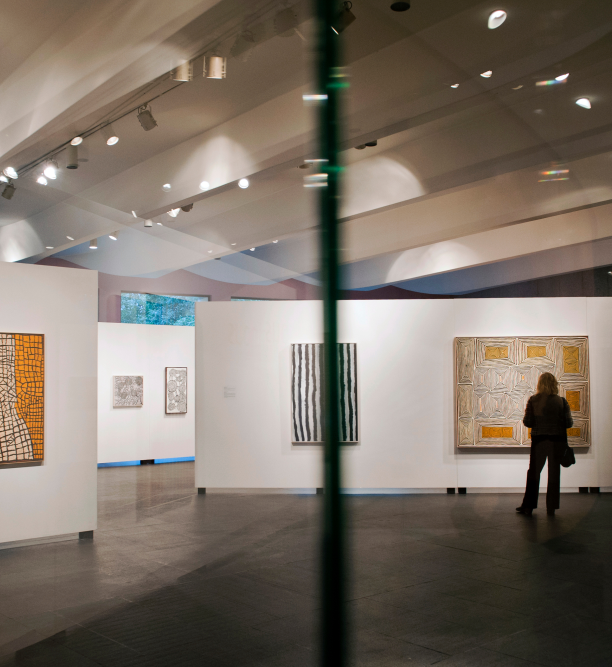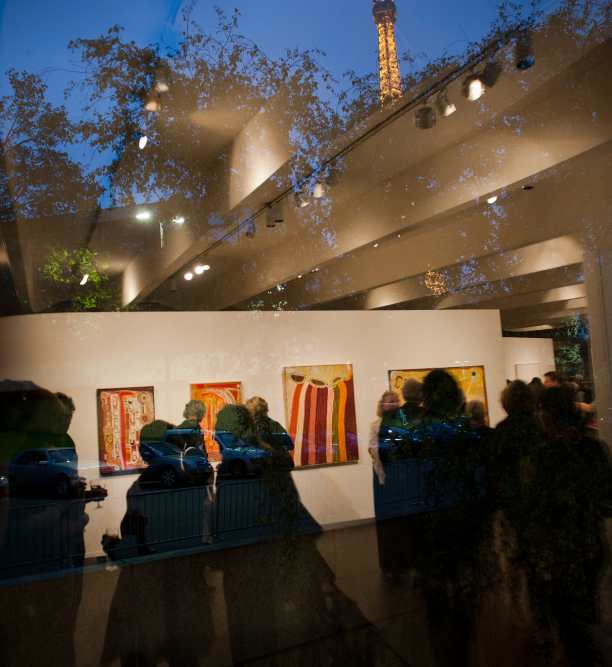HELEN READ
Founder and director of Palya Art Tours (formerly Didgeri Air Art Tours), and Palya Art.
Born in Clifton, Bristol, UK into a medical and travelling family, Helen’s qualifications are in fine art, Hospital and community nursing, midwifery, commercial piloting, as Director of a company facilitating logistics for visitors to meet First Nations artists across North West Australia, and as an art curator and collector.
Following fine art training Helen studied to be a State Registered Nurse in Bristol, England. From here she went to West Africa to nurse and, whilst in Nigeria, realised she needed a pilot’s licence to maintain continuity in health-care giving in remote areas.
Helen took her first flying lesson in 1978 in England followed by twin engine and multiple instrument ratings, tail-wheel and float-plane endorsements, night rating and airline theory qualifications in Australia, where her Mother had live and family still lives.
Helen is the first recipient of the Robin Miller Dicks Memorial Award for nurses wanting to fly. A second Robin Miller Dicks Memorial Award was given to Helen after combining flying and nursing for the Pintupi Homelands Health Service in 1985.
Administering care and vaccines to people living 600 kms west of Alice Springs in the Walungurru (Kintore) and Kiwirrkurra areas, Helen had arrived a few weeks after the ‘Pintupi Nine’ had ‘come in’ from living traditional lifestyles in the inner deserts of Australia. Helen, using her flying and nurse training to cover a wide area, was shocked at everyone’s living conditions, worse than she had seen in Africa.
A painter herself, in awe of the artists’ paintings being created in the remote areas she was flying over, realised one way to bring attention to the strength and beauty of Pintupi culture and living conditions was to entice people with means and influence out to meet the artists, see the extraordinary paintings, the magnificent country flying low, and, witness the conditions.
In 1986 Helen Started her air art touring company Didgeri Air Art Tours, now Palya Art Tours.
A background to nursing, piloting and art can be seen below.
With events so dynamic and often overwhelming, to be written about later, Helen became a passionate collector and caretaker of a carefully selected body of Indigenous artworks, gathered as a form of diary. The artworks were been made available for the purpose of aiding research and education and to reach new audiences at a time when there was little interest in Australian Indigenous art and cultures. Now known now as the Helen Read Collection part of Helen’s collection include the touring exhibitions A Thousand Journeys 1996 – 1999 and Luminous: Desert Masterpieces from the Helen Read Collection 2005-2013
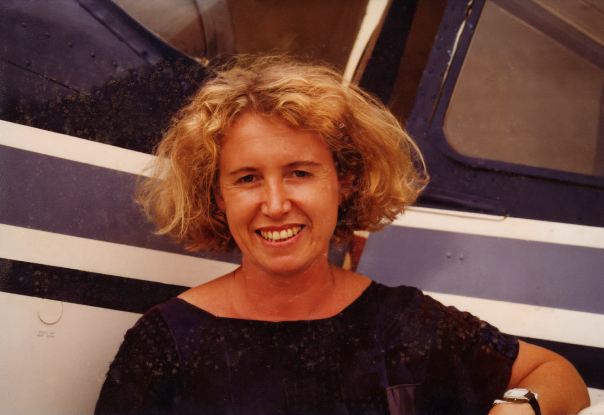
Helen Read with Cessna 185 call sign “Foxtrot Lima Uniform” Photo: Liz Laverty
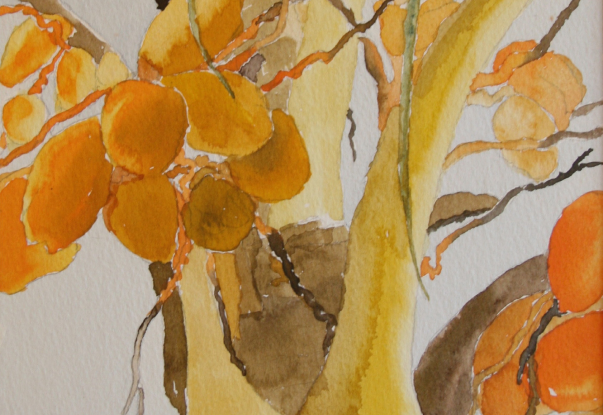
Helen Read’s painting ‘Palmier’ 1996 Watercolour 285 X 190 mm
Born in Clifton, Bristol, UK into a medical and travelling family, Helen’s qualifications are in fine art, Hospital and community nursing, midwifery, commercial piloting, as Director of a company facilitating logistics for visitors to meet First Nations artists across North West Australia, and as an art curator and collector.
Following fine art training Helen studied to be a State Registered Nurse in Bristol, England. From here she went to West Africa to nurse and, whilst in Nigeria, realised she needed a pilot’s licence to maintain continuity in health-care giving in remote areas.
Helen took her first flying lesson in 1978 in England followed by twin engine and multiple instrument ratings, tail-wheel and float-plane endorsements, night rating and airline theory qualifications in Australia, where her Mother had live and family still lives.
Helen is the first recipient of the Robin Miller Dicks Memorial Award for nurses wanting to fly. A second Robin Miller Dicks Memorial Award was given to Helen after combining flying and nursing for the Pintupi Homelands Health Service in 1985.
Administering care and vaccines to people living 600 kms west of Alice Springs in the Walungurru (Kintore) and Kiwirrkurra areas, Helen had arrived a few weeks after the ‘Pintupi Nine’ had ‘come in’ from living traditional lifestyles in the inner deserts of Australia. Helen, using her flying and nurse training to cover a wide area, was shocked at everyone’s living conditions, worse than she had seen in Africa.
A painter herself, in awe of the artists’ paintings being created in the remote areas she was flying over, realised one way to bring attention to the strength and beauty of Pintupi culture and living conditions was to entice people with means and influence out to meet the artists, see the extraordinary paintings, the magnificent country flying low, and, witness the conditions.
In 1986 Helen Started her air art touring company Didgeri Air Art Tours, now Palya Art Tours.
A background to nursing, piloting and art can be seen below.
With events so dynamic and often overwhelming, to be written about later, Helen became a passionate collector and caretaker of a carefully selected body of Indigenous artworks, gathered as a form of diary. The artworks were been made available for the purpose of aiding research and education and to reach new audiences at a time when there was little interest in Australian Indigenous art and cultures. Now known now as the Helen Read Collection part of Helen’s collection include the touring exhibitions A Thousand Journeys 1996 – 1999 and Luminous: Desert Masterpieces from the Helen Read Collection 2005-2013

Helen Read with Cessna 185 call sign “Foxtrot Lima Uniform” Photo: Liz Laverty

Helen Read’s painting ‘Palmier’ 1996 Watercolour 285 X 190 mm
HELEN READ
Written by Territory Q Magazine 2015
For nearly three decades Helen Read has worked to bring a better understanding of Indigenous art and culture to a wider audience. This awareness contributes toward bringing improved conditions and better health to Australian Indigenous communities.
Helen’s engagement with the lives, art and culture of Indigenous Australians began when, in the late 1970s, after working in west Africa, she came to Melbourne to further her flying training. She also trained as a midwife in order to use both qualifications for remote area health work.
Working as a nurse and pilot for the Pintupi Homelands Health Service in Kintore and Kiwirrkurra – 600 kms west of Alice Springs – in the mid 1980’s, Helen was ‘grown up’ to see Pintupi country, people and paintings by artists and other community members. Flying with Helen, country men and women would show her their country, teaching her to look; really look and observe what she was seeing.
Comparing her experience of working with people in Pintupi country to working with people in West Africa, – health conditions in Australia being far worse – Helen realised she needed to bring a better awareness of Australia’s first people to the general public. Working with local community members there seemed no better way than through facilitating meetings with Indigenous people on their own country. By working with artists Art Centres visitors could meet artists and be enveloped in art and culture in a mutually respectful environment.
Helen, a commercial pilot with twin engine and instrument ratings, has flown a diverse range of people across northwest Australia through Palya Art Tours (ex Didgeri Air Art Tours). Supporting Art Centres in turn support Palya Art to hold exhibitions and learn about Palya Art Tours.
AVIATION
Commercial Flying
Helen started flying lessons in Bristol UK going solo before heading out to Australia to train as a midwife in 1978.

Helen with Cessna 185 ‘Foxtrot Lima Uniform’ during parachute operations at Corowa 1984
Receiving the first Robin Miller Dicks Memorial Award Helen was able to train for the flight tests after passing the aeronautical exams, and became a commercial pilot in 1984. Robyn Miller Dicks was called ‘The Sugarbird Lady’ as she nursed and flew across the Kimberley her Mooney aircraft giving polio vaccines in sugar lumps. Robyn was the daughter of well known author Mary Durack and Western Australian aviator Horrie Miller.
Helen gained hours of flight time and aircraft handling experience through parachute operations in ‘FLU’ a tail-wheel aircraft. With this experience she was later able to borrow a tail-wheeled Cessna 180 and head north.
Helen preferred to keep her parachute on (unused!) when flying the parachutists. Everyone else seemed to like hurtling themselves ground-ward Helen says, good friend Ray Perry included.
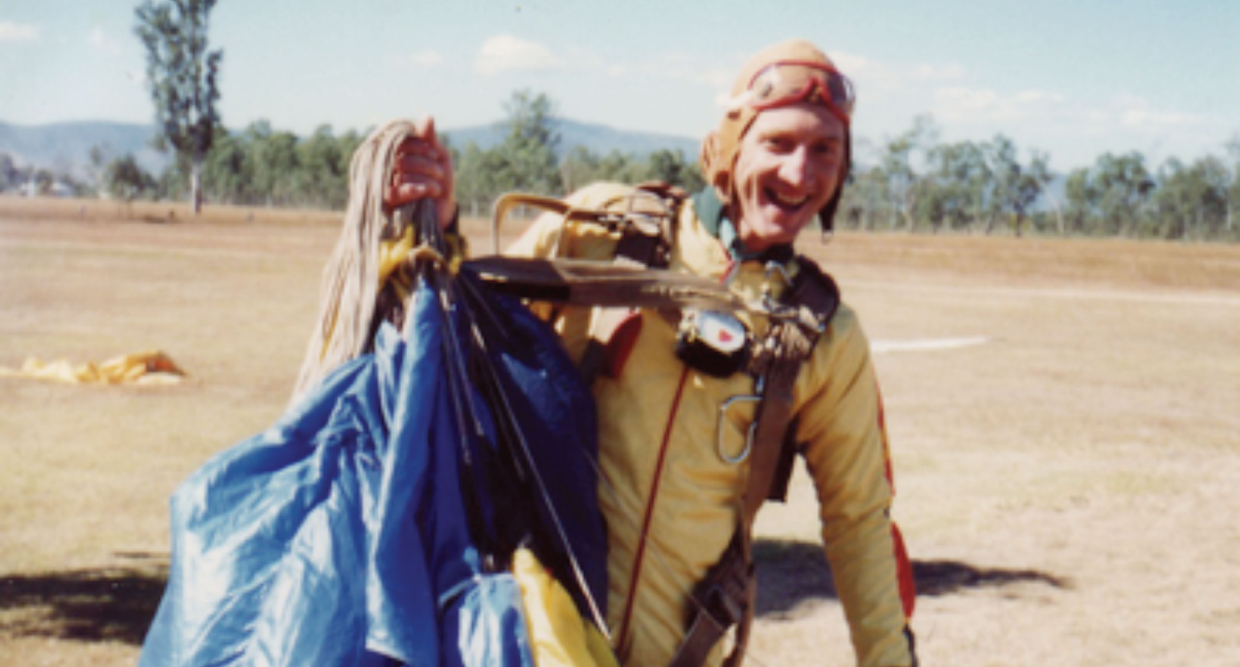
Ray Perry, fellow lover of all things airborne.
With enough hours gaining experience in handling an aircraft to know a pilot can never have enough, Helen felt ready to start looking for combined work flying and nursing.
With their introduction and phone calls to Alice Springs and poor radio wave ‘rad-phone’ connections out to Kintore, I was offered the job of nursing for the Pintupi Homelands Health Service in the Western Deserts bringing an aeroplane with me. Flying a tail-dragger was useful as the propellers are fixed in a nose-up attitude, not only helping with short take offs and landing but also to avoid stone damage to the propellers and engine on rough strips.
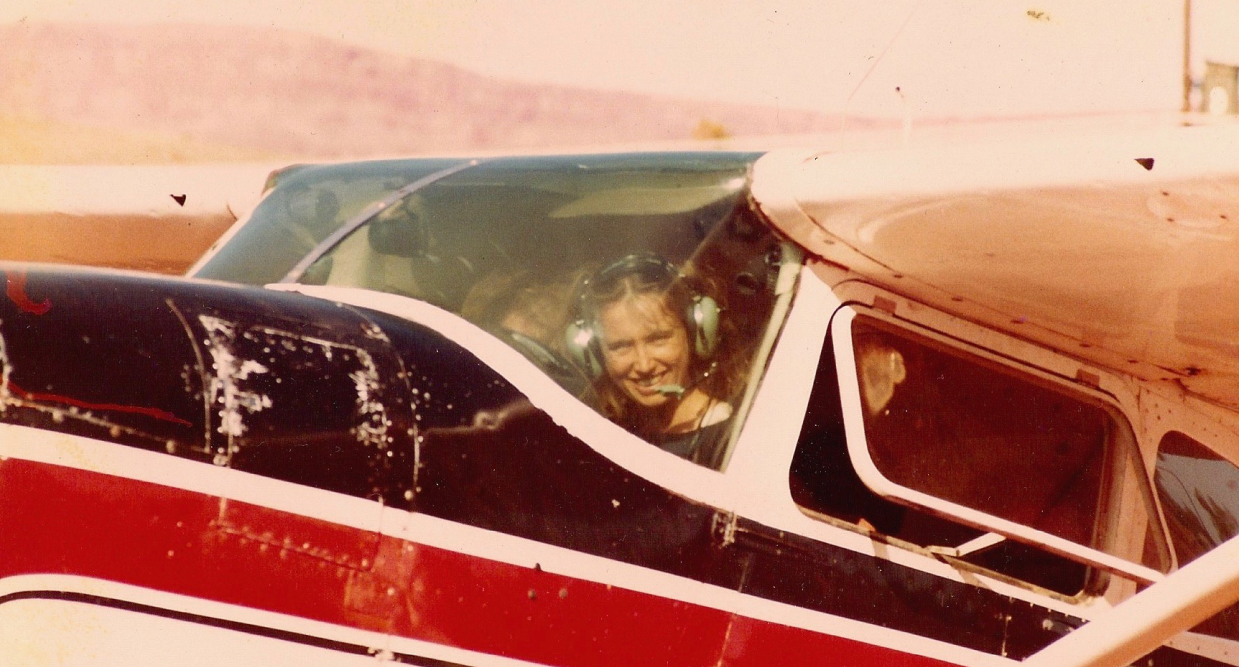
Helen with ‘Tango Tango Whiskey’ the Cessna180 tailwheel aircraft she flew out to Walungurru to reach outstations and hold health clinics.
With enough hours gaining experience in handling an aircraft to know a pilot can never have enough, Helen felt ready to start looking for combined work flying and nursing.
Following a twin engined aircraft endorsement and studies in Instrument flying, Helen flew for various air charter companies in different aircraft types out of Broome whilst trying to work out how to get people with means and influence out to remote areas to meet First Nations Peoples and bring support.
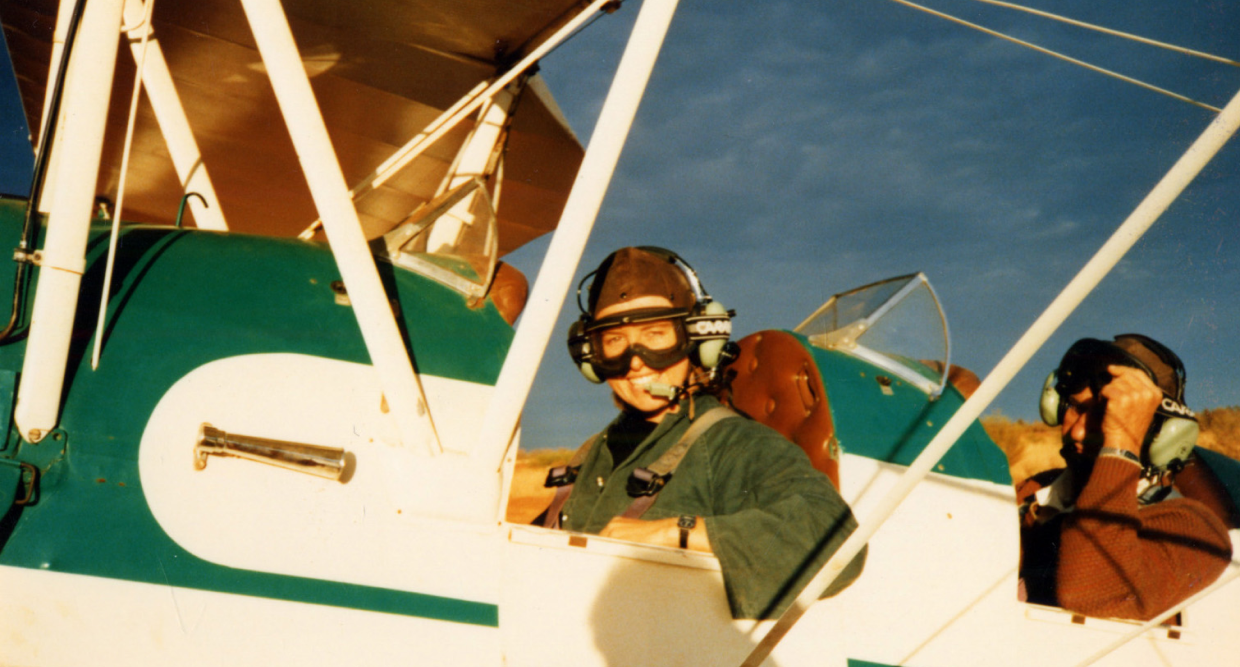
Helen with friend Dr. Pevie in his Tiger Moth out of Alice Springs
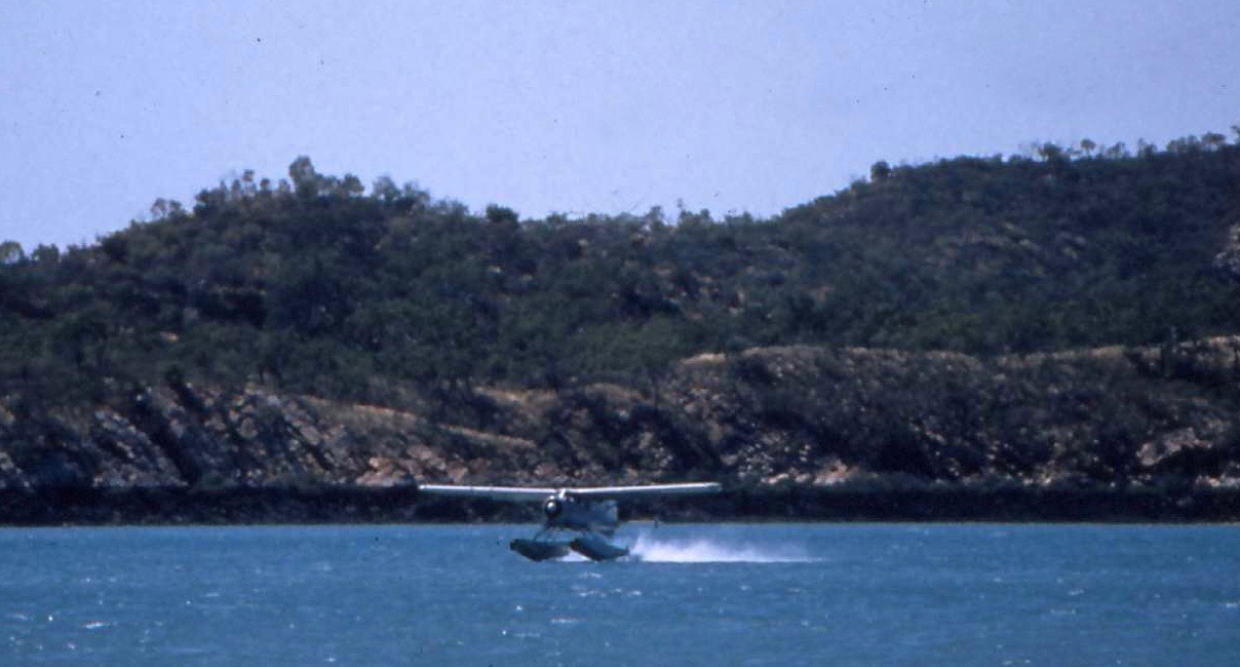
Helen pictured flying ‘IDO’ in to land on North West Kimberley’s Cone Bay.
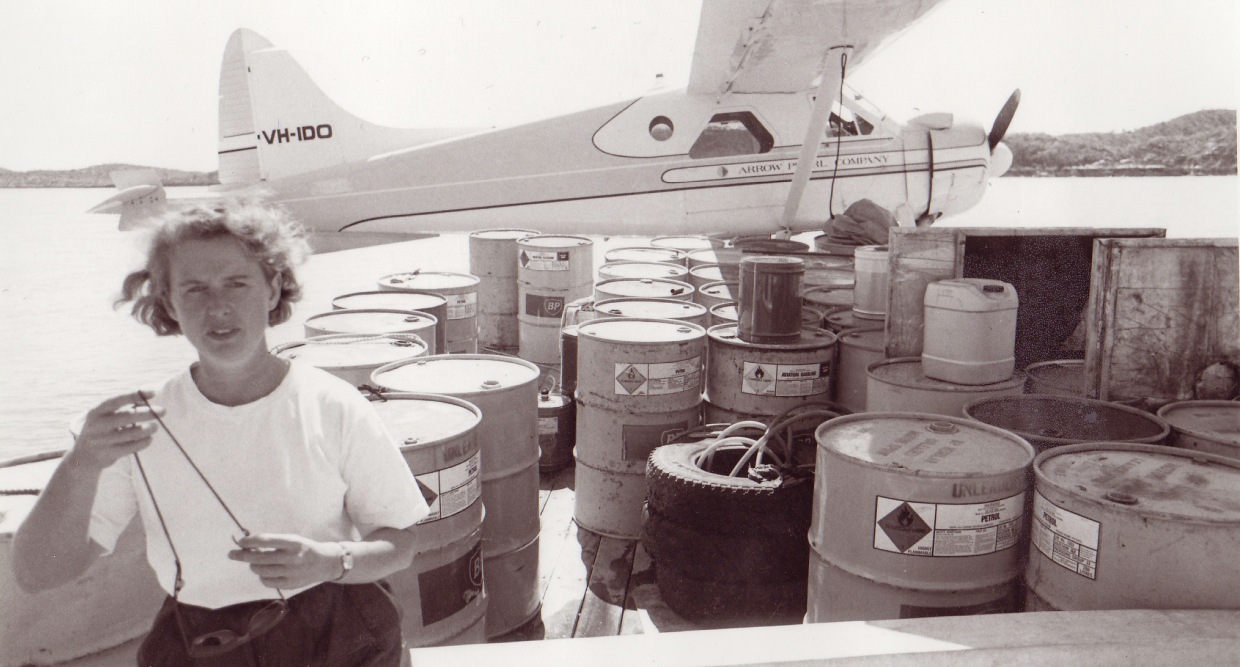
Refuelling ‘IDO’ from Cone Bay’s moving pontoon.
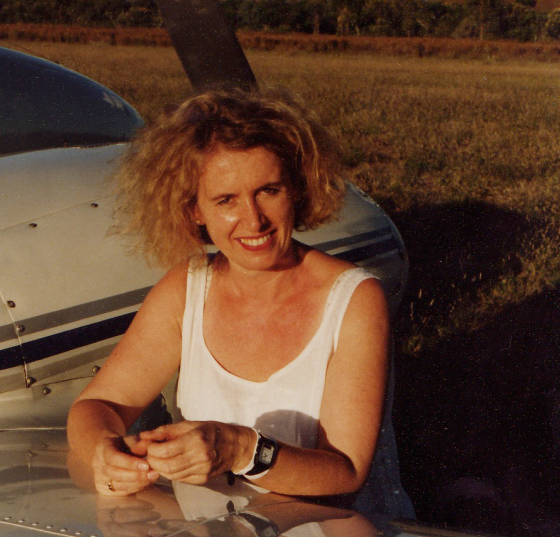
Helen Read with one of her favourite aircraft, ‘Delta Mike Golf’, twin engined Piper Aztec.
Studies to pass the Airline Transport Licence exams took a while in Sydney but Helen enjoyed learning about operations and performance, navigation, meteorology, basic gas turbine engines, aviation law and knowing she’d prefer to fly light aircraft at lower levels over remote areas at her own pace than fly airliners.
‘DMG’, a terrific work-horse for the weight she can carry compared to her size, robustness and flight time endurance.
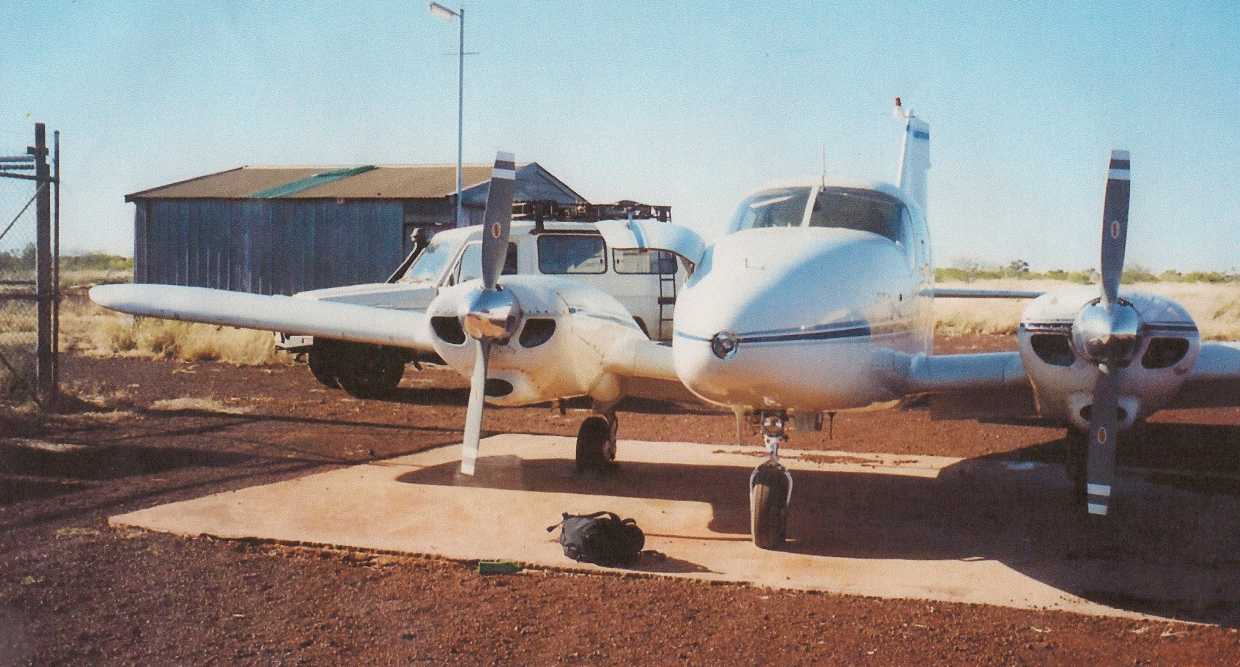
Delta Mike Golf’, Piper Aztec on the ground at Wirrimanu, Balgo Hills, 1997
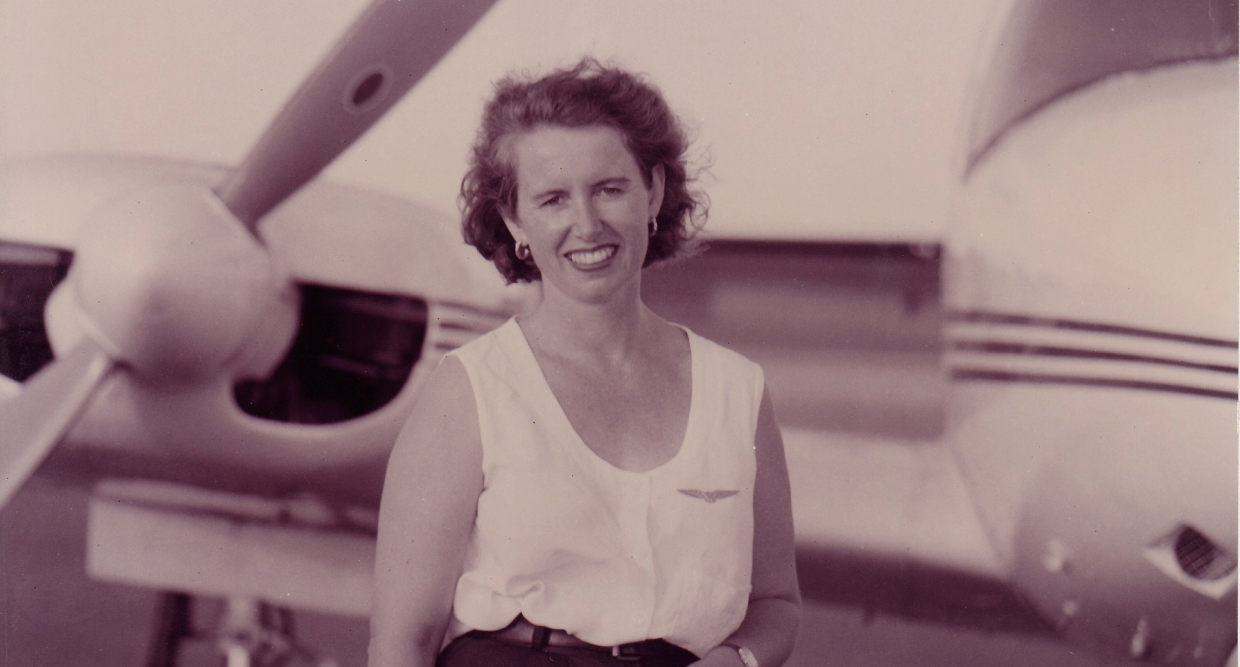
The larger aircraft, ‘Papa Delta November’, a Piper Navajo, is ideal for her long distance higher weight carrying capabilities.
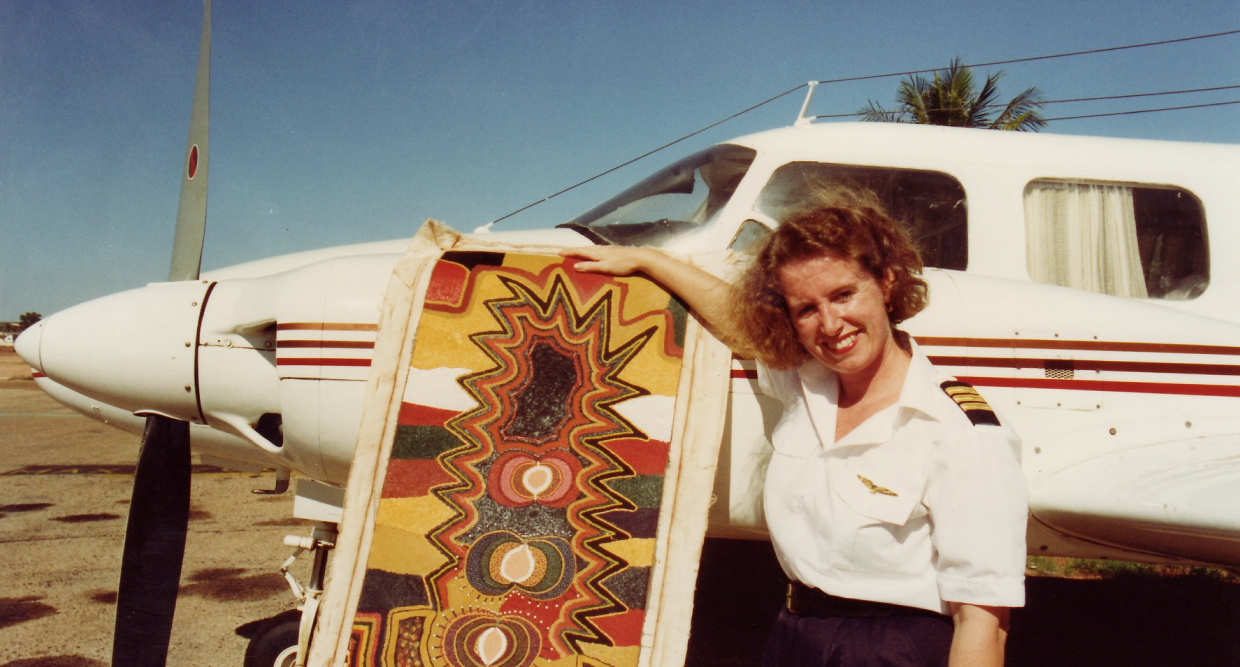
Richard Tax Tjupurrula’s painting associated with the rain-making ritual at Kurtal, Warlayirti Artists, Wirrimanu, Balgo Hills, Helen and aircraft ‘PDN’ 1993
COMMUNITY NURSING
Helen trained as a State Registered Nurse at Frenchay Hospital, Bristol UK, following her Parents and Grandparents training at the same Hospital.
After qualifying, Helen joined her cousin, Dr. Alan Williamson, Doctor of Tropical Medicine, working through the Liverpool School of Tropical Medicine and the World Health Organisation in Nigeria in 1977. Helen’s role was assisting with research to prevent Malaria by conducting community clinics in distant regions where people often had not seen a person without dark skin before, and were frightened.
The death of her young cousin Alan in Nigeria prevented Helen’s return so she sought nurse-flying work in Australia. The people who requested her services were the Pintupi Nation, just after the ‘Pintupi Nine’, affectionately known as ‘The Bush Mob’, had connected with family in the newly settled community of Kiwirrkurra. The experience Helen had gained caring for people who had not seen ‘white-fellas’ before in Africa turned out to be helpful in Central Australia.
In-between studying for instrument, commercial and senior commercial flying subjects, Helen worked in a variety of nursing roles including in emergency departments, operating theatres, medical and surgical wards, as community midwife and in neonatal intensive care, all of which she loved before taking up commercial flying operations full time flying people out to remote areas of Central and North West Australia.
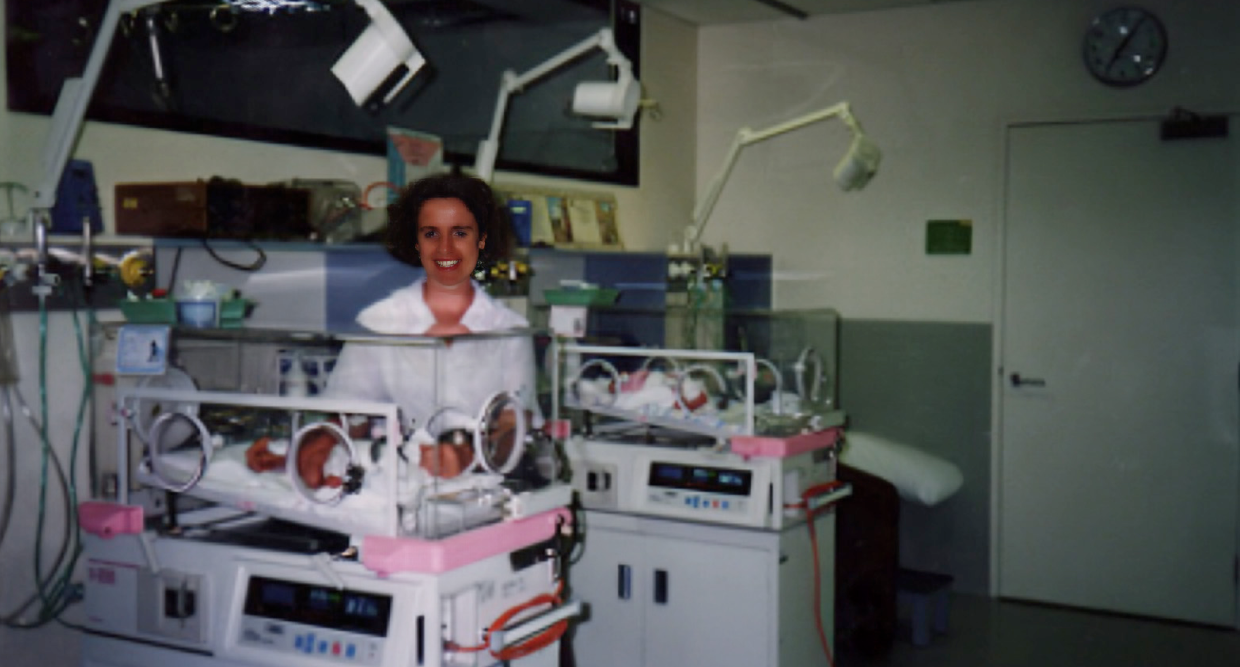
Neonatal Intensive Care Unit, Royal Women’s Hospital Melbourne 1978
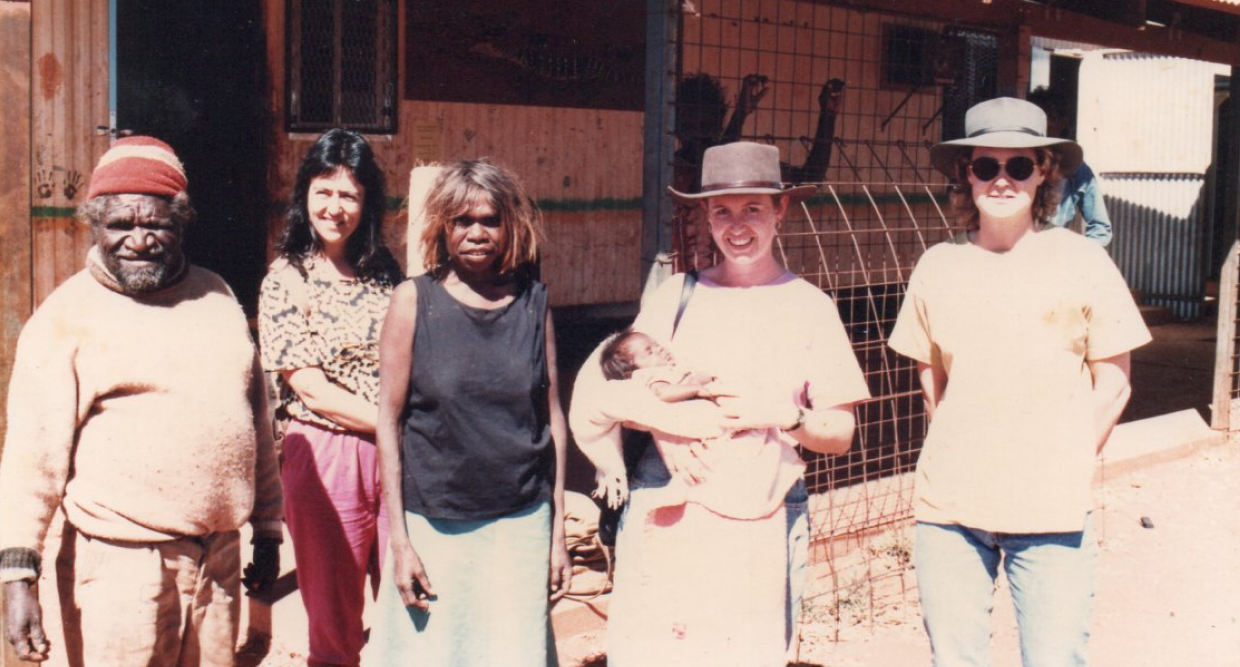
Traditional Doctor – Maparn – Dr George Tjapaltjarri, friend Ruth Crouch, Health Worker Numeda Nampitjinpa, Helen Read (given the name Nampitjinpa too is therefore Numeda’s sister), Nursing Sister Jinny Healey: Staff of Pintupi Homelands Health Service in Walungurru, Kintore 1985
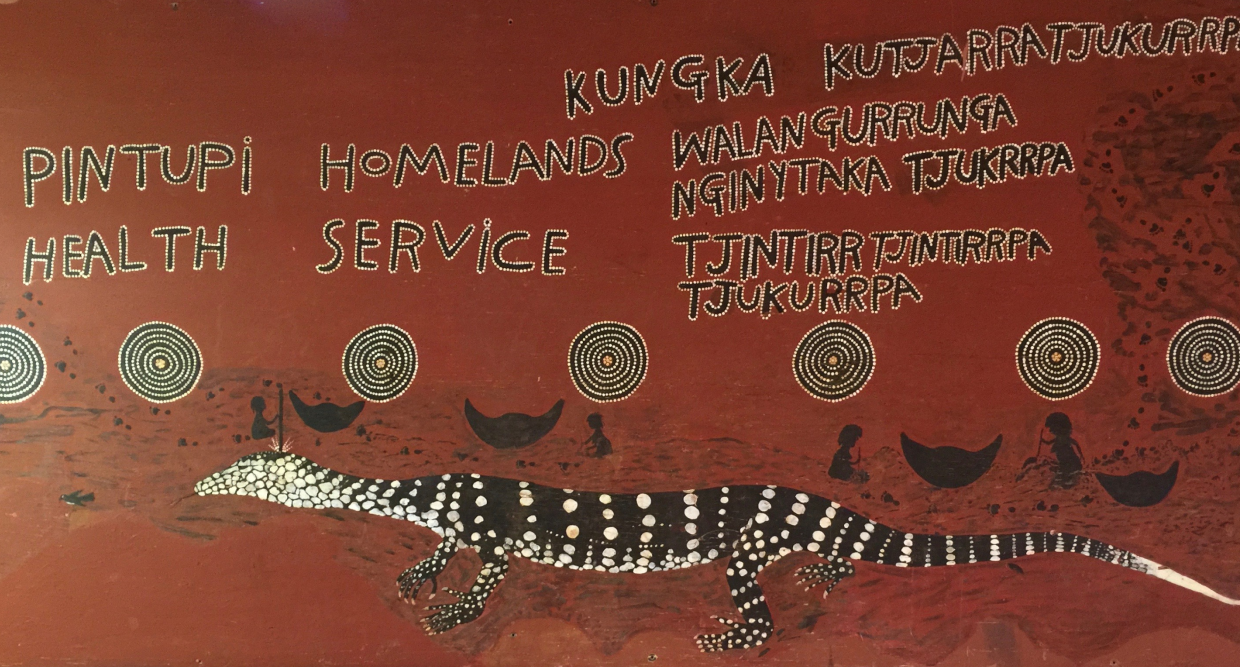
Sign outside Kintore Clinic 600 kms West of Alice Springs, Gibson Desert 1985
THE HELEN READ COLLECTION
During Helen’s ‘sharing the learning’ journeys across Central Australia, Kimberley, Arnhem Land and Island areas, Helen collected a group of artworks as a form of diary.
As the Collection gathered the artworks were requested to form a touring exhibition by NSW Regional Gallery Director, Janie Raffin. Helen agreed as this would be ideal for research, education and in reaching new audiences. Curated by Pauline Guthrie of Tin Sheds Gallery, University of Sydney, the show began touring in 1996. The exhibition was titled by Helen ‘A Thousand Journeys’ because of the multiple flights undertaken and the stories each artwork had to tell.
Very few Australian Aboriginal Art exhibitions (as titled then), had been seen by New Australians, with a few notable exceptions of Collections held in University Art Museums,State Galleries and in the National Gallery in Canberra.
A Thousand Journeys catalogue
A Thousand Journeys was loaned to the Flinders University Art Museum as a resource with the intention of re-showing the exhibition after ten years as a ‘window looking back’.
‘A Thousand Journeys’ was re-exhibited at Flinders University Art Museum in Adelaide twenty years later and was of great interest to people seeing the development and changes in cultural expression, art practice and the importance of the artists’ oeuvre in Indigenous Art History.
https://news.flinders.edu.au/blog/2017/11/25/pivotal-period-aboriginal-australian-art-captured/
https://www.adelaidereview.com.au/arts/visual-arts/2018/01/04/thousand-journeys-two-decades/
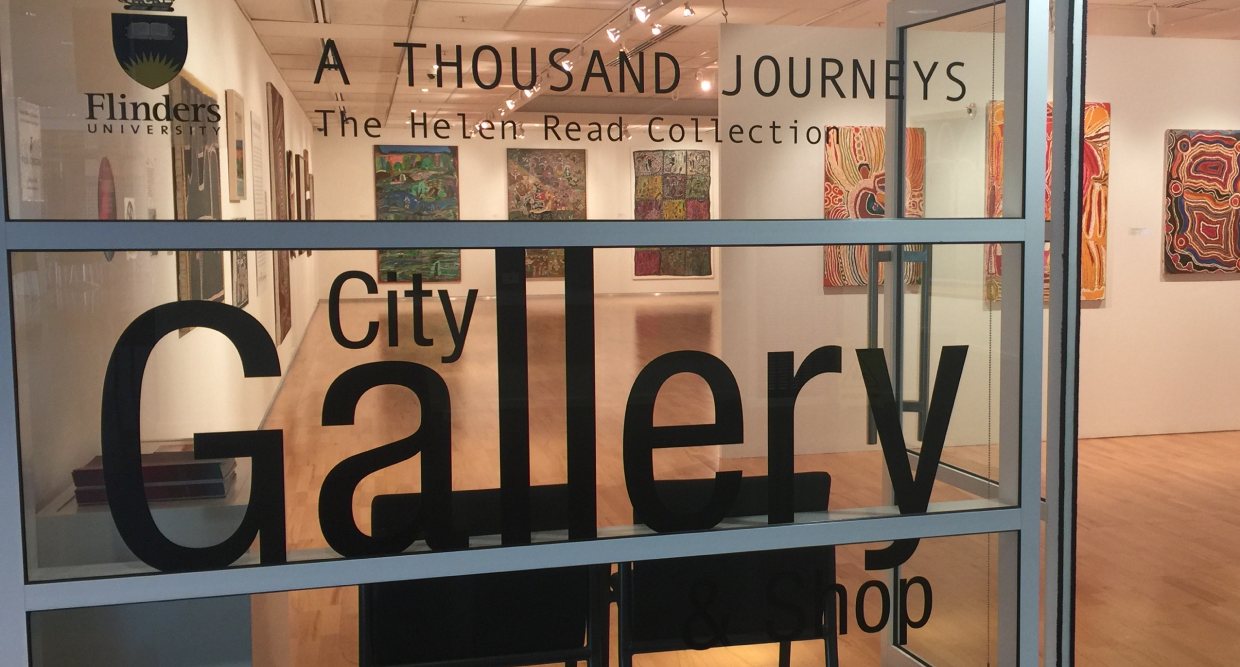
Flinders University Art Museum showing ‘A Thousand Journeys’ 2017.
A further exhibition, this time of entirely Central Australian artists from the Helen Read Collection, was toured, along with an education package, by the generosity and understanding of the Manly Art Gallery and Museum (MAG&M). Curation was assisted by Ace Bourke and the show titled ‘Luminous’ by Penelope Barker.
The exhibition was toured to regional galleries and universities before going on to exhibit at The Australian Embassy in Paris in 2013 followed by excerpts of the show at the Australian Embassy in Berlin, called ‘Sunflying’.
Luminous catalogue (link to Luminous catalogue PDF)
Individual artworks from the Collection are requested to exhibit by various Regional Galleries and Institutions, fulfilling the Collection’s purpose.
